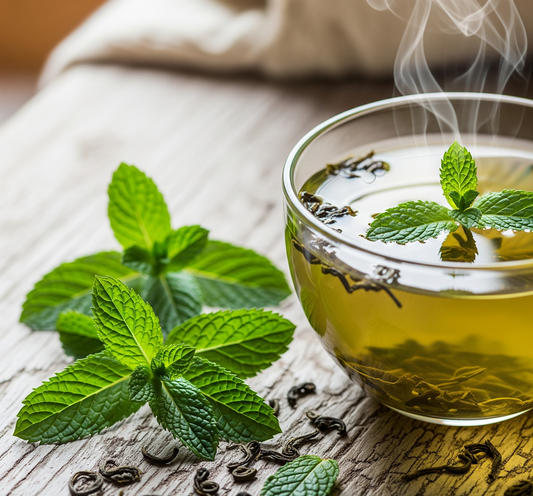White tea undergoes minimal processing, resulting in a delicate, sweet flavor and light color. Black tea is fully oxidized, producing a bold, robust taste and dark color. White tea contains 15-30 mg of caffeine per 8 oz cup, while black tea averages 47-90 mg. Both offer health benefits, but white tea is higher in antioxidants. The tea that's best depends on personal preference for flavor, caffeine level, and health priorities. Ultimately, both provide an enjoyable tea-drinking experience.
Exploring the world of tea can be a delightful journey, especially when comparing two popular varieties: white tea vs black tea. Both types of tea come from the same plant, Camellia Sinensis, but they differ significantly in their processing methods, flavors, health benefits, and caffeine content.
In this article we will explore the most interesting differences and similarities between the two most famous types of teas, helping you make an informed choice about which tea you should get.
Understanding Tea Processing: Why Are Teas Different?
All tea comes from one singular plant; Camellia Sinensis, but why are there so many varieties of teas like white tea, black tea, green tea, oolong tea, and so on?
The main difference lies in the processing of the tea leaves. There is one major factor that causes the difference - oxidation level.
Oxidation Levels in Teas
Oxidation is a natural process that occurs when tea leaves are exposed to oxygen after being harvested. This reaction triggers enzymatic changes, darkening the leaves and deepening their flavors. The level of oxidation determines a tea’s taste, color, and aroma. Black tea is highly oxidized, giving it bold, malty, and sometimes smoky notes, while green and white teas undergo minimal oxidation, preserving their fresh and delicate flavors.
-
White Tea: Minimal oxidation. One of the least processed teas, preserving its delicate flavors.
-
Green Tea: Low oxidation (0% to 15%), resulting in fresh and vegetal flavor notes.
-
Oolong Tea: Partially oxidized (10% to 70%), falls between green tea and black tea in terms of oxidation levels
-
Black Tea: Fully oxidized (90% to 100%), giving it a bold, rich, and robust taste.
For a deeper dive into tea oxidation, check out this blog: What is Tea Oxidation?
Now, let’s get into the main discussion for White Tea vs. Black Tea and explore the differences and similarities between these two teas.
What is White Tea?
 White tea is one of the least processed types of tea, known for its delicate flavor and subtle aroma. Primarily produced in China, particularly in the Fujian province, white tea has been enjoyed for centuries. Today, white tea is cultivated globally, with India and Nepal also producing and exporting premium varieties.
White tea is one of the least processed types of tea, known for its delicate flavor and subtle aroma. Primarily produced in China, particularly in the Fujian province, white tea has been enjoyed for centuries. Today, white tea is cultivated globally, with India and Nepal also producing and exporting premium varieties.
Production Process of White Tea
The production process involves minimal intervention: young leaves and buds are simply plucked and allowed to wither in the sun before being dried. This gentle process preserves the tea's natural qualities, resulting in a light, sweet flavor profile with floral and grassy notes.
If you want to dive into the flavorful world of White Teas, here is a blog where you can Understand the Dynamic Production Process of White Tea.
Characteristics of White Tea
Flavor: White tea is characterized by its delicate, refreshing taste, often described as sweet, smooth, and more on the floral side without any bitterness. Popular varieties in our collection include White Prakash, Silver Yeti, and White Peony, each offering unique flavor nuances.
Appearance: White tea leaves are covered in fine white hair like fuzz on its layer, giving them a silvery appearance. When brewed, the tea produces a pale yellow or light amber color.
Health Benefits of White Tea
 White tea is not just a treat for the palate; it also offers numerous health benefits due to its high antioxidant content. Here are some potential benefits of drinking white tea:
White tea is not just a treat for the palate; it also offers numerous health benefits due to its high antioxidant content. Here are some potential benefits of drinking white tea:
Rich in Antioxidants: White tea contains a higher concentration of antioxidants such as catechins and polyphenols, which can help combat free radicals that causes aging and illness.
Skin Health: The antioxidants in white tea may contribute to improved skin health, protecting against UV damage and promoting a youthful appearance.
Weight Management: A study from the National Library of Medicine suggests that white tea’s anti‐inflammatory and antioxidant properties may aid in body weight management by boosting metabolism and promoting fat oxidation.
Read more about the Benefits of White Tea.
If you’re looking to incorporate white tea into your daily routine, you can pick from our range of the best organic white tea from Nepal Tea Collective.
And make sure to not skip out on our multiple award-winning white tea, White Prakash. With its vanilla, buttercream, and fresh flowers flavor notes, it might just end up being your favorite new beverage.
How to Brew White Tea?
To brew white tea perfectly, follow these simple steps:
-
Heat the Water
Start by heating your water to the right temperature. Aim for 170°F to 180°F (76°C to 85°C). If you don’t have a thermometer, boil water and let it cool for about 5-7 minutes.
-
Measure Your Tea
Use approximately 2 grams of white tea leaves for every 8 ounces of water. If you’re using a blend of leaves and buds, this ratio works well.
-
Pre-Warm Your Teacups
To enhance your tea experience, pre-warm your teacups by pouring a little hot water into them and then discarding it. This helps maintain the temperature of your brewed tea.
-
Steep the Tea
Pour the hot water over the tea leaves in your teapot or infuser. Let the tea steep for 3 to 4 minutes, depending on your taste preference. Start tasting at the 2 minute mark and continue until you reach your desired flavor.
-
Serve and Enjoy
Once steeped, pour the tea into your pre-warmed cups. Enjoy your delicate and flavorful white tea plain, or add a touch of honey or lemon if desired!
What is Black Tea?
 Black tea is the most talked about and the most popular tea globally. It makes up over 68% of total tea consumption worldwide and more than 80% of tea consumption in the U.S., according to the Tea Association of the USA. It is one of the most widely consumed types of tea globally, with significant production in countries like India, Sri Lanka, China, and most recently Nepal.
Black tea is the most talked about and the most popular tea globally. It makes up over 68% of total tea consumption worldwide and more than 80% of tea consumption in the U.S., according to the Tea Association of the USA. It is one of the most widely consumed types of tea globally, with significant production in countries like India, Sri Lanka, China, and most recently Nepal.
Production Process of Black Tea
Black tea leaves are fully oxidized tea, resulting in a bold flavor and dark color. Compared to white tea, black tea undergoes multiple processing steps, including withering, rolling, oxidation, and drying, which contribute to its robust flavor profile and rich aroma.
Here is an in-depth blog on the Production Process of Black Tea.
Characteristics of Black Tea
 Flavor: Black tea is known for its strong, full-bodied flavor, which can vary from malty and sweet to earthy and astringent. Varieties like Assam, Darjeeling, and Earl Grey offer distinct tasting notes. Nepal Tea Collective’s premium Top of the world tea, Everest Black offers earthy eucalyptus and sweet honey notes, whereas Kumari Gold offers more nuanced caramel and sweet flavor notes.
Flavor: Black tea is known for its strong, full-bodied flavor, which can vary from malty and sweet to earthy and astringent. Varieties like Assam, Darjeeling, and Earl Grey offer distinct tasting notes. Nepal Tea Collective’s premium Top of the world tea, Everest Black offers earthy eucalyptus and sweet honey notes, whereas Kumari Gold offers more nuanced caramel and sweet flavor notes.
If you want to read more, here is a about the different types of Black teas, its characteristics, and its flavor notes: An Expert's Guide to the Different Types of Black Tea
Appearance: The leaves of black tea are dark and twisted, and when brewed, the tea produces a deep amber or reddish-brown color.
Health Benefits of Black Tea
 Like white tea, black tea also boasts a range of health benefits, largely due to its antioxidant properties. According to research in the International Journal of Health Science drinking black tea may protect against the onset of several chronic disorders. Here are some potential benefits of drinking black tea:
Like white tea, black tea also boasts a range of health benefits, largely due to its antioxidant properties. According to research in the International Journal of Health Science drinking black tea may protect against the onset of several chronic disorders. Here are some potential benefits of drinking black tea:
Cognitive Function: The caffeine and L-theanine in black tea may enhance focus and cognitive performance, making it a great choice for a mid-morning pick-me-up.
Digestive Health: The antioxidants present in Black tea may support digestive health and help with gut bacteria balance.
Weight Management: Similar to white tea, black tea may aid in weight management by boosting metabolism.
If you’re looking to incorporate black tea into your daily routine, you can pick from our range of the best organic black tea from Nepal Tea Collective.
And while you’re at it, check out our award-winning black tea, Kumari Gold if you’re looking for a delicious anti-oxidant-rich and energy-boosting beverage.
How to Brew Black Tea
To brew black tea perfectly, follow these simple steps:
-
Boil the Water
Start by boiling fresh water. The ideal temperature for black tea is around 200°F to 210°F (93°C to 100°C). If you're using a kettle, let it come to a rolling boil.
-
Measure Your Tea
Use 2 grams of loose black tea leaves for every 8 ounces of water. If you prefer a stronger flavor, you can add an extra half teaspoon.
-
Preheat Your Teapot
Pour a little boiling water into your teapot to preheat it. Swirl the water around and then discard it. This helps maintain the temperature while brewing.
-
Steep the Tea
Add the measured tea leaves to your preheated teapot and pour the boiling water over them. Let the tea steep for 3 to 5 minutes, depending on your taste preference. Start tasting at the 4 minute mark.
-
Remove the Tea Leaves
Once steeped, remove the tea leaves by pouring the tea through a strainer or using an infuser.
-
Serve and Enjoy
Pour the brewed tea into your cup. You can enjoy it plain or add milk, sugar, or lemon to taste. Relax and savor your delicious cup of black tea!
Comparing White Tea and Black Tea
|
Factor |
White Tea |
Black Tea |
|
Processing |
Minimal processing |
Fully oxidized |
|
Flavor |
Delicate, sweet, floral |
Bold, robust, malty |
|
Caffeine Content |
15-30 mg per cup |
47-90 mg per cup |
|
Health Benefits |
Higher in antioxidants, good for skin and weight management |
Boosts cognition, supports heart and digestive health |
When considering white tea vs black tea, it's essential to understand the key differences and similarities:
Processing: White tea undergoes minimal processing, involving only withering and drying, while black tea is fully oxidized and undergoes multiple processing steps including rolling and fermentation.
Flavor Profile: White tea offers a delicate, sweet, and floral taste with subtle grassy notes, whereas black tea provides a bold, robust, and complex flavor, with variations from malty to earthy.
Caffeine Content: White tea typically contains about 15-30 mg of caffeine per 8 oz cup. Black tea typically contains 47-90 mg of caffeine per 8 oz cup, with an average of 47 mg.
Health Benefits: Both teas are rich in antioxidants and offer various health benefits, but white tea is often considered superior in antioxidant content due to its minimal processing.
Which tea should I choose? Black or white?
We have specified how you can choose between Black Tea and White Tea.
Flavor: White tea is known for its delicate and light flavor. It often has subtle floral and grassy notes with a natural sweetness. If you enjoy milder, more nuanced flavors and a gentle tea experience, white tea might be a better choice. Black tea offers a bold and robust flavor profile. It can have malty, earthy, fruity, or even spicy notes, depending on the specific type of black tea. If you prefer a stronger, more full-bodied tea with a brisk character, black tea is a good option.
Caffeine Content: White tea generally contains less caffeine than black tea. If you are sensitive to caffeine or prefer a lower caffeine content, white tea might be a better choice. Black tea typically has a higher caffeine content than white tea. If you're looking for a tea that provides more of an energy boost, black tea may be preferable.
Health Benefits: Both white and black teas are known for their potential health benefits due to their antioxidant content. White tea is often considered to have a higher concentration of antioxidants than black tea due to its minimal processing, but both can be part of a healthy diet.
If you are looking for good white teas, then our White Prakash has won numerous awards in international tea events including the AVPA Paris award. You can find it here.
Regardless of which tea you choose, both white and black teas provide a unique and enjoyable drinking experience, each with its own set of flavors and health advantages. So, whether you're sipping a calming cup of white tea or a bold brew of black tea, you’re sure to enjoy an amazing tea-drinking experience.
FAQ
Do white tea and black tea come from the same plant?
Yes, both white and black tea originate from the Camellia Sinensis plant. The key difference lies in how the tea leaves are processed.
Which tea has higher caffeine content: white tea or black tea?
Black tea contains more caffeine than white tea, making it a better choice for those looking for an energy boost.
What are the top health benefits of drinking black tea?
Black tea is known for its potential benefits, including improved heart health, better digestion, and enhanced cognitive function.
How does the taste of white tea compare to black tea?
White tea has a delicate, mild, and floral taste, while black tea is bold, rich, and full-bodied.
About the Author
Nishchal Banskota is the founder of Nepal Tea Collective, dedicated to offering the finest Nepali teas. With years of experience in the tea industry, Nishchal is passionate about sharing the culture and craftsmanship of Nepali tea with the global tea industry. Learn more about Nepal Tea Collective and explore a variety of award-winning teas that bring you closer to the heart of Nepal.
Sources




